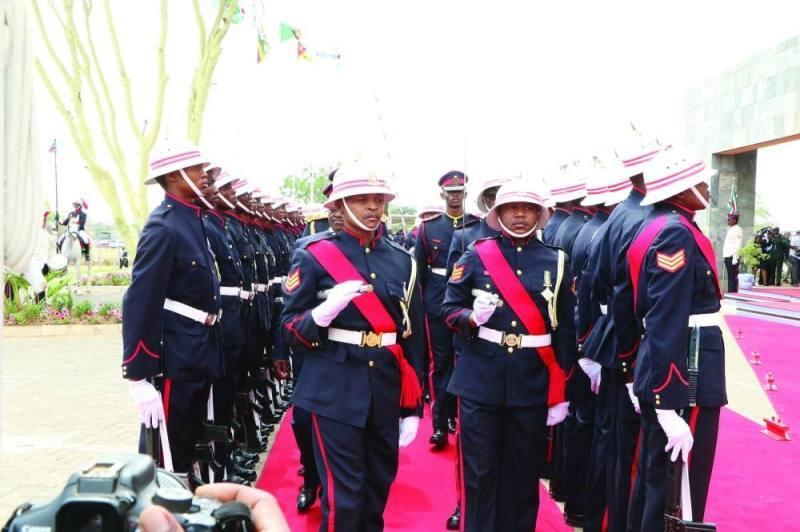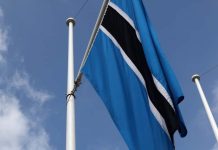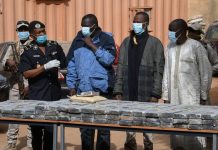Africa-Press – Botswana. Commander-in-Chief of the armed forces, President Dr Mokgweetsi Masisi will join the Botswana Defence Force (BDF) members and multitudes of Batswana as the men and women in uniform reflect on the rich history of their existence in a colourful military parade at the National Stadium tomorrow.
After 47 years of existence, BDF prides itself in a well-trained and professional security organ that fully executes its mandate and mission with precision.
A much fancied event locally, the BDF uses the commemoration to showcase its military might and state-of-the-art hardware and technology in its quest to defend territorial integrity and borders of Botswana as a sovereign state.
Through numerous displays such as mock battles, dog displays and obstacles, BDF demonstrates that it is not spared from ravages of illicit regimes in some war-torn nations.
Other entertaining events lined up for tomorrow, BDF protocol and public affairs director, Colonel Magosi Moshagane said included the civilian participation drill, assault course, BDF Day presentation and horse display. The crowd will be kept alive by the ceremonial band that usually boost the troop’s morale during their military engagements.
In its 47 years of existence, the BDF has effectively restored law and order where internal security and peace were threatened, the latest being the deployment of troops to a joint international military operation, the Southern African Mission in Mozambique (SAMIM), a SADC military operation to bring peace and stability in the region.
In December 1992, Lieutenant Colonel Thulaganyo Masisi led the first ever external mission of the BDF when his contingent of 300 soldiers flew into Somalia to be part of the UN peacekeeping and humanitarian mission.
Code-named Operation Restore Hope, the UN military outfit included forces from the US and Britain, amongst others.
From 1993 to 1994, a team of BDF officers participated in a UN peacekeeping mission in Rwanda as observers.
In the same period, BDF took part in a peacekeeping mission in Mozambique as well as in the SADC military intervention in Lesotho in 1998.
The last decade (2007-2017), had seen BDF establish a defence command and staff college, adopt a brigade grouping structure, enrol female non-commissioned officers and introduce special entrant officer cadet programme.
In 2007, women officers were inducted into the BDF rank and file while 2015 saw the inclusion of the first ever women recruit privates.
In 2012, BDF established the defence command and staff college, which provided professional military and academic education, training and development.
At the time of its formation, the BDF prevailed over challenges in the midst of apartheid regimes in the sub-Saharan region in the 1980s. The indigenous people were involved in liberation struggles against colonisers in neighbouring countries.
At the centre of such countries was Botswana, a land-linked country, which had just gained independence from Britain in 1966 when there was relative peace in Bechuanaland, but the liberation struggles were much felt here.
Down south, a bitter struggle against the apartheid regime was raging in South Africa while on the eastern and northern borders Zimbabwe (South Rhodesia) and Zambia (North Rhodesia) were involved in decolonisation struggles of their own.
To the west, Namibia under the rule of South Africa’s apartheid regime, was also fighting their own liberation struggle.
All the upheavals posed a real security threat to Botswana, which at the time did not have a military force, but only dependent on a small paramilitary Police Mobile Unit (PMU).
Some 11 years after independence, the BDF was formed from the PMU and had the late Lt Gen. Mompati Merafhe as its first commander.
At its formation in 1977, Botswana was classified among the poorest nations in the world and her defence and security relegated to a police force, whose mandate competed with other social welfare needs such as health and education.
BDF did not inherit and military equipment and infrastructure from which a defence force would be founded.
Despite this the BDF grew in leaps and bounds to become an efficient force that would successfully thwart and halt any external aggression.
The immediate past – President Lt Gen. Dr Seretse Khama Ian Khama, then a 24-year-old Brigadier in the army ranks, became its deputy commander.
Perhaps the most fatal incident in the history of the organisation was the infamous Lesoma ambush.
In February 27, 1978, about 15 members of a year-old inexperienced BDF met their demise during an ambush by the then Rhodesian Armed Forces at the Lesoma Sand Ridge.
The brave soldiers’ ultimate sacrifice happened in the midst of the regional turmoil of the Zimbabwe Chimurenga war.
The Lesoma incident is now a permanent feature in the country’s calendar, commemorated as annual National Heroes Day.
dailynews
For More News And Analysis About Botswana Follow Africa-Press






